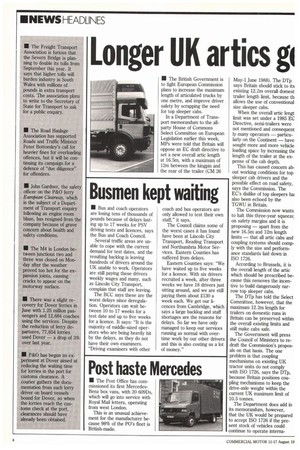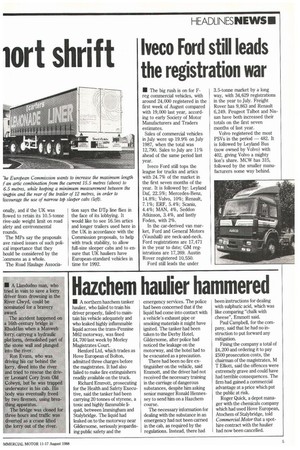Longer UK arta g iort shrift
Page 4

Page 5

If you've noticed an error in this article please click here to report it so we can fix it.
• The British Government is to fight European Commission plans to increase the maximum length of articulated trucks by one metre, and improve driver safety by scrapping the need for top sleeper cabs.
In a Department of Transport memorandum to the allparty House of Commons Select Committee on European Legislation earlier this week, MPs were told that Britain will oppose an EC draft directive to set a new overall artic length at 16.5m, with a maximum of 12m between the kingpin and the rear of the trailer (CM 26 May-1 June 1988). The DTp says Britain should stick to its existing 12.2m overall domest trailer length limit, because th allows the use of conventional. size sleeper cabs.
When the overall artic lengt limit was set under a 1985 EC Directive, semi-trailers were not mentioned and consequent ly many operators — particularly on the Continent — have sought more and more vehicle loading space by increasing the length of the trailer at the expense of the cab depth.
This has caused concern about working conditions for top sleeper cab drivers and the possible effect on road safety, says the Commission. The EC's dislike of top sleepers ha: also been echoed by the TGWU in Britain.
The Commission now wants to halt this-three-year squeeze, on safety margins and it is proposing — apart from the new 16.5m and 12m length limits — that all artic cabs and coupling systems should comply with the size and performance standards laid down in ISO 1726.
According to Brussels, it is the overall length of the artic which should be prescribed because this removes the incentive to build dangerously narrow top sleeper cabs.
The DTp has told the Select Committee, however, that the maximum 12.2m length for trailers on domestic runs in Britain can be preserved within the overall existing limits and still make cabs safe.
The Government will press the Council of Ministers to redraft the Commission's proposals on that basis. The one problem is that coupling mechanisms on existing UK tractor units do not comply with ISO 1726, says the DTp, because Britain positions coupling mechanisms to keep the chive-axle weight within the current UK maximum limit of 10.5 tonnes.
The Department does add in its memorandum, however, that the UK would be prepared to accept ISO 1726 if the present stock of vehicles could continue to operate interim onally, and if the UK was bowed to retain its 10.5-tonne rive-axle weight limit on road afety and environmental rounds.
The MPs say the proposals ave raised issues of such poli[cal importance that they hould be considered by the ;ornmons as a whole.
The Road Haulage Associa fion says the DTp line flies in the face of its lobbying. It would like to see 16.5m artics and longer trailers used here in the UK in accordance with the Commission proposals, to help with truck stability, to allow full-size sleeper cabs and to ensure that UK hauliers have European-standard vehicles in time for 1992.












































